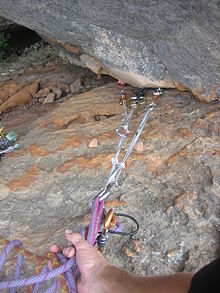Stand (climbing)
As a stand or stand when is climbing a locking position inside or at the top of a climbing route designated.
A stand enables a rope team to be secured, especially in routes with several pitches . It prevents the entire rope team from being torn out of the wall if a member of the rope team falls.
In contrast to an intermediate belay, in which the rope runs through and enables further climbing, the belayer at the stand connects firmly to the wall via one or more fixed points . In addition to the belayer, other people from the rope team can secure themselves at the stand.
Stand security
In a Vorstiegssturz directly in the state during a multi-pitch tour will fall factor (2 fall factor) and thus the falling load of the prior extreme. Failure of the stand as a result of all fixed points breaking out has generally fatal consequences and can lead to the fall of an entire rope team. It is therefore recommended and taught to always perform a stand backup redundantly using several backup points.
Climbing in the lead climbing and 'follow the distance between the stands must not exceed the simple rope length, while rappelling with single rope half rope length. If there is a risk of having to abseil, and thus the limitation to half the rope length (with single rope), half the rope length is not exceeded even when climbing.
In sport climbing , modern or refurbished multi-pitch routes often have fixed stands, which now usually have two bolts. If there are no bolts, the stand is often set up using mobile safety equipment when climbing in the mountains . A safety device is built on the wall using technical aids such as clamping wedges , friends , rock hooks , slings , accessory cord and snap hooks .
Rope command "Stand"
The call "Stand" is also used as a rope command when climbing in German-speaking countries. It means that the first rope operator has secured himself at a stand and no longer needs to be secured by his rope partner. Thus, this rope command prompts the securing climbing partner to remove the first rope from the safety device.
See also
literature
- Chris Semmel, Georg Sojer: Overview of stand construction , status July 2012.
- Chris Semmel, Florian Hellberg : Stand construction - Part 1: Stand in the wall . In: DAV Panorama, 2/2009, pp. 74-77.
- Chris Semmel, Florian Hellberg: Stand construction - Part 2: Look closely, build smart . In: DAV Panorama, 3/2009, pp. 62–65.

